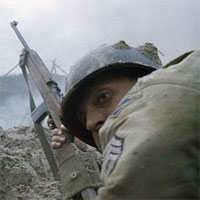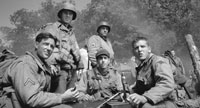M1 Carbine

Designed as a support weapon, the semi-automatic M1 carbine was lighter and less powerful than the M1 Garand rifle. The original Army request was for a weapon that could replace handguns for second-line troops. The initial design was done by David M. Williams and later refined by Winchester Repeating Arms. The M1 carbine was accepted by the U.S. Army on September 30, 1941.
A variation of the M1 carbine was the M2 carbine, which was identical except that it had a selective fire feature allowing for either semi-automatic or fully-automatic fire and used a 30-round magazine. The M2 carbine had a rate of fire of 650-700 rounds per minute, and was put into service on October 23, 1944.
From June 1942 to August 1945 over 6,000,000 M1 carbines were produced by nine different manufacturers.
| Manufacturer | Production | % |
|---|---|---|
| Inland Manufacturing Division (GMC) | 2,632,097 | 43% |
| Winchester Repeating Arms Co. | 828,059 | 13.5% |
| Underwood-Elliot-Fisher Co. | 545,616 | 8.9% |
| Saginaw Steering Gear Division (GMC) | 517,212 | 8.5% |
| National Postal Meter Co. | 413,017 | 6.8% |
| Quality Hardware & Machine Co. | 359,666 | 5.9% |
| International Business Machines Corp. | 346,500 | 5.7% |
| Standard Products Co. | 247,160 | 4% |
| Rock-Ola Co. | 228,500 | 3.7% |
The M1 carbine was used in the Korean War and the opening years of the Vietnam War, but was eventually replaced by the M16.
The only significant appearance of the M1 carbine is in the hands of Sergeant Horvath, who carries one throughout the entire film. 36 carbines (a mixture of M1 and M1A1s) were used during the movie's production.

